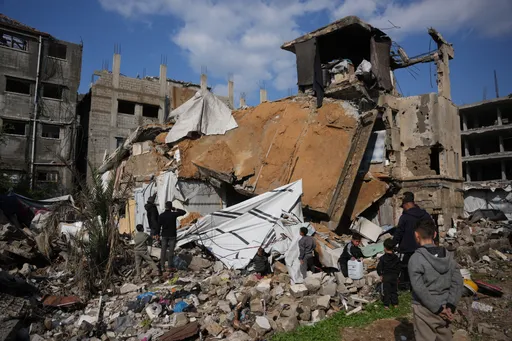In the late 1980s, Dr Kelin Wang was a young geophysicist pursuing a doctorate at the University of West Ontario, Canada. He was born and raised in China, where he had heard stories about how a prediction had saved thousands of lives in the city of Haicheng, which was hit by a 7.5-magnitude quake in 1975.
Among seismologists who study what happens beneath the ground, the Haicheng earthquake is known as a “fortuitous success” because authorities had evacuated the city before the tremors struck and collapsed the city’s buildings.
Wang, who is now a Senior Research Scientist at the Geological Survey of Canada, wanted to advance the science of earthquake prediction. So in 2006, he interviewed survivors and local authorities in Haicheng and went over newly declassified documents in the hope of finding out what actually happened. He couldn’t have been more disappointed.
“It was my hope to be able to predict earthquakes. That’s why I travelled to China for research. But what I discovered brought me back to reality,” he tells TRT World.
“I found that the history of Haicheng was not as previously advertised. Effectively, it was a successful prediction, but the success was fortuitous.”
That earthquake came after a series of 500 smaller shocks which affected a particular area that later turned out to be the epicentre. Under the tight control of Communist Party of China, it was relatively easy for authorities to order evacuation on short notice.
Such success in saving lives was never repeated. The very next year, an earthquake in China’s Tangshan region killed at least 242,000 people in what is regarded as one of the worst natural disasters in history.
The deadly back-to-back earthquakes in southern Türkiye on February 6 have rekindled the debate around earthquake prediction and why it is taking scientists so long to come up with a way to anticipate a big shaker.
A shaky science
“Earthquakes may not be predictable,” says Susan Elizabeth Hough, a seismologist at the United States Geological Survey (USGS).
“Why an individual earthquake starts may depend on so many little details that we can never hope to understand well enough to say that an earthquake is going to hit next Monday or a month from now,” she tells TRT World.
“It’s like trying to figure out why one leaf falls off a tree at a particular time. Leaves are still easier — at least they turn yellow, red and brown before they fall.”
What scientists do know fairly well is where the earthquakes will strike, she says.
For decades, scientists have studied fault lines or fractures where tectonic plates — broken chunks of the Earth’s surface — meet and clash with each other. Modern instruments and tools have helped them map out where and how often earthquakes have happened in the past.
Seismologists look at a time scale of hundreds or thousands of years. Past trends can tell them with relative certainty if the next ‘big one’ is expected within a certain — and rather ambiguous — time frame. But precisely when and where that big one will strike is an answer that continues to elude them.
For something to qualify as an earthquake prediction, it has to indicate an exact time, location and magnitude, says Hough, who is also author of the book Predicting the Unpredictable: The Tumultuous Science of Earthquake Prediction.
“I am in California. The next big earthquake on the San Andreas Fault could be tomorrow, like the 1906 earthquake, or it could be a hundred years from now.”
Since Charles Richter came up with a system to measure the strength of an earthquake in the 1930s, scientists have focused on precursors — geological cues or other observations — that take place before a major temblor.
For instance, changes in the levels of underground water aquifers, gas emissions, electromagnetic waves and strange behaviours in animals have all been associated with earthquakes.
“A lot of things happen before an earthquake. The problem is that they do not always happen before an earthquake and can also happen when there's no earthquake,” says Wang of the Geological Survey of Canada.
The precursor study tends to look at things after the fact — after an earthquake has taken place. A closer look into potential precursors usually reveals that the phenomenon in question happens all the time and not just before an earthquake — such as a dog barking or howling for no apparent reason.
Wang says there are some precursors that are hard to explain — like a fluctuation in groundwater and “aberrant animal behaviour,” even though their usefulness in predicting an earthquake remains questionable.
But the most promising indicator could be foreshocks — a series of shocks that come before a big earthquake, he says. “However, a very small number of big earthquakes are preceded by these foreshock events.”
For someone who had started his career with the hope of one day finding a way to predict an earthquake, Wang now says the best option humanity has is to build stronger buildings to withstand powerful shocks.
“The most heartbreaking scene for me is (to see) a collapsed building side by side with a standing building. These two buildings went through the same shaking. The people in the collapsed building also deserved the chance to survive.”
Algorithms v Mother Nature
Predicting when a big earthquake might hit and its intensity based on the study of past patterns along a fault line seems like a logical way to tackle the problem, but it is also challenging.
The Hayward Fault in the San Francisco Bay region of the US is one of the most researched fault lines, with a well-documented record of around a dozen earthquakes.
“But if you look at the individual earthquakes, some of them were 100 or 10 years apart. Some of them are 100 or 90 years apart.” The last major 6.8-magnitude earthquake hit the area in 1868.
Even if there hasn’t been any success as of yet, machine learning can help scientists better understand the correlation between earthquakes and the potential precursors and proposed patterns.
“I haven’t seen anything really promising so far. But we are now bringing much bigger computational horsepower to solve the problem,” says Hough.
For now, something mightier seems to be standing in the way of powerful algorithms and brilliant minds. One just has to look at the most recent earthquake disaster.
Two fissures cut across Türkiye — the North Anatolian Fault, which runs close to the Black Sea, and the East Anatolian Fault which sits under provinces to the south, including Kahramanmaras and Hatay. The February 6 earthquake jolted regions along the East Anatolian Fault.
Even though both faults are known to be seismically active, the North Anatolian Fault, which lies close to Istanbul, has produced a series of large earthquakes, including one in Erzincan in 1939 and another in Izmit in 1999 in which thousands were killed.
“That (the North Fault) turned into a textbook example of how earthquakes on a fault trigger each other like dominoes,” says Hough.
The next big one was expected to be in the Sea of Marmara, where the 1,200-kilometre-long North Anatolian Fault lies.
“Well, where does the next earthquake happen? It’s on a different fault system in a completely different direction.”
“Sometimes it feels like it’s a message that ‘Oh you think you understand this. Well the Earth is more complicated than that.’”
























